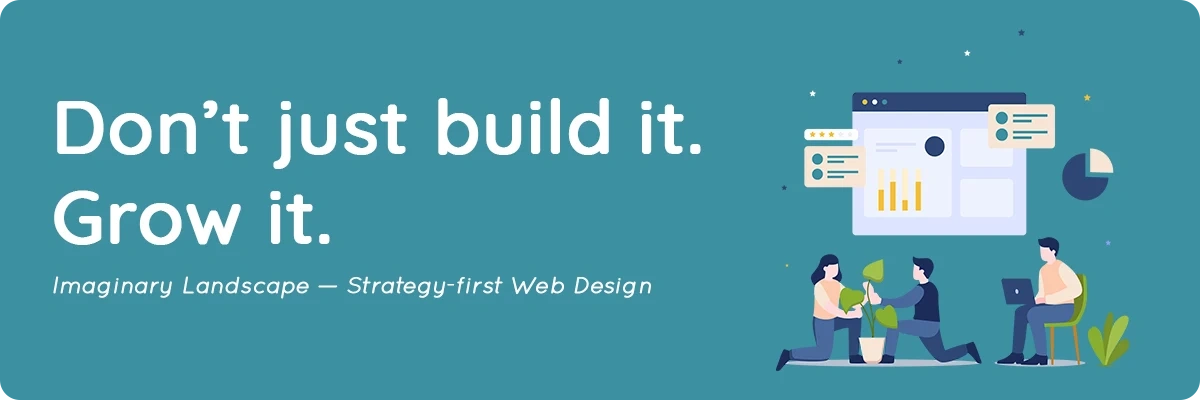Digital Agency Website Strategy: Lessons Any Brand Can Apply
Recently updated on
Is your next website redesign going to follow the same old playbook? Or are you ready to use the same digital agency tool that top agencies use to drive real business growth?
In 2025, your website is no longer just a digital brochure. It's your most powerful sales tool, and simply looking modern isn't enough. The most successful digital agencies know this, and their websites are an open playbook for success—modeling high-converting design, seamless user journeys, and content built to drive trust.
If you're considering a redesign, these aren't just trends to watch; they're strategies that can turn your website from a cost center into a powerful growth engine.
1. Strategy-Driven Design > Pretty Pixels
Thinking that trendy colors and dynamic visuals are all it takes for a website to drive meaningful conversions? Think again. In a time where visually appealing sites can be created from anywhere, a purposeful website that is strategy-driven is what truly stands out like a diamond in the rough.
A beautiful website without a clear purpose is like an expensive billboard located in the middle of nowhere. It may be eye-catching, but it's not effective.
Brands like yours could learn a thing or two from Digital agency websites, after all, they know how to balance aesthetics and functions. This means creating sites that:
- Prioritize user flow from the first click to conversion
- Guide different buyer personas through tailored journeys
- Utilize storytelling and structure to build trust quickly
These principles apply to any business website aiming to attract interest and convert traffic into genuine opportunities. However, always remember that before starting any redesign project, it is essential to understand user behavior and business goals before opening any design tool. After all, what good is a visually appealing site if it doesn't generate any leads?

2. Mobile-Native Design Takes the Lead
Mobile-first is old news. In 2025, we're seeing a complete shift to mobile-native design—where sites are conceived and prototyped from a mobile user's perspective first, not merely adapted for small screens after the fact.
That means:
- Menus designed for thumbs, not cursors
- Streamlined copy, optimized for quick reading
- Minimal, performance-friendly design systems that scale beautifully across screens
Over 60% of all website traffic now comes from mobile devices. And yet, many business websites still treat mobile as a second-tier experience. The cost? Lost leads, frustrated users, and a damaged first impression.
A poor mobile experience can also tank your Core Web Vitals—metrics that now affect both SEO and user satisfaction. From slow-loading assets to touch targets that frustrate users, ignoring responsive design is no longer an option.
Having a slow, clunky mobile site doesn't just frustrate users—it damages your credibility, hurts conversions, and weakens your SEO performance. Ignoring responsive design can negatively impact Core Web Vitals like page speed, interactivity, and layout shift—all of which influence search rankings and user satisfaction.
According to this article, mobile responsiveness isn't just about scale—it's about business strategy. If your site doesn't perform well on mobile, you're likely missing out on traffic, engagement, and leads.
This makes mobile responsiveness a foundational strategy, not an afterthought, because a site that performs well on mobile platforms performs well everywhere.
3. Modular CMS Architecture Is In
Modern websites are no longer rigid, all-in-one systems—they're flexible ecosystems designed to adapt and scale. Enter modular CMS architecture, a web development approach that connects multiple API-driven services through a modern JavaScript environment for faster, more efficient site builds.
Why it matters:
- Reusable content blocks that scale across pages
- Easy content updates by non-technical users
- Faster turnaround for launching new pages or campaigns
- More agility for marketers, less developer dependency
With mobile performance now influencing SEO rankings and user expectations rising, modular CMS platforms are gaining traction. They're replacing outdated, monolithic systems that hinder team productivity.
4. Smarter CTAs That Guide, Not Just Prompt
A recent Forbes article highlighted an essential truth: audience attention is the new currency, and landing page design plays a pivotal role in capturing it. While crafting a compelling call-to-action is crucial, the entire visual journey leading up to the CTA must guide users with clarity and purpose.
The classic "Contact Us" button just doesn't cut it anymore. In 2025, leading websites are treating CTAs as part of an experience, not a standalone element. Here's what that evolution looks like:
- CTAs tailored to buyer intent and page purpose
- Progressive, low-commitment action paths like "View Case Study" → "Explore Solutions" → "Schedule a Consult"
- Strategic microcopy that reduces friction and builds user confidence
This isn't just a design trend—it's a strategic shift. Businesses that embrace intuitive, conversion-oriented journeys will stand out by making it easier for users to say "yes" at every step.
CTA language, placement, and logic aren't just design decisions—they're business-critical tools that shape the user experience and drive results.
5. Content That Builds Trust, Not Just Fills Space
About a year ago, Rolling Stone published a surprisingly insightful piece on what businesses should consider before building a website. The big takeaway? The most effective sites are laser-focused on the audience—what they want, what they need, and what drives them to act.
That principle—putting the audience at the center—anchored all nine of the article's key recommendations. It’s also a lesson many digital agencies have finally absorbed. Gone are the days of vague promises, buzzword soup, and glossy-but-empty design. Today’s smartest agencies are building websites that work harder by saying more with less
Here's how modern digital agency websites (and honestly, any effective business site) are evolving:
- Clear, concise messaging without the jargon
- Real-world case studies that show measurable outcomes
- Defined services and differentiators, upfront and easy to find
Whether you're a startup or an established brand, these shifts matter. In a world of short attention spans and high expectations, clarity builds trust—and trust moves visitors from curiosity to conversion.
6. Performance & Security as UX Essentials
A fast, secure site doesn't just improve user experience—it defines it. In 2025, performance and security aren't technical afterthoughts. They're foundational to how users perceive, interact with, and trust your brand online.
Website visitors now expect digital experiences that are seamless, lightning-fast, and safe. A site that loads in seconds and protects its data builds immediate confidence. One that lags, crashes, or looks sketchy? That's a bounce—or worse, a lost lead.
Here's why performance and security are now non-negotiable in UX:
- Speed is a trust signal. Slow load times frustrate users and kill conversions. Search engines agree—site speed is a core ranking factor.
- Security is visibility. HTTPS, data encryption, and safe browsing protocols aren't optional—they're expected.
- Accessibility is reachable. ADA-compliant design ensures that every visitor, regardless of ability, can interact with your site.
- Scalability is sustainability. Modern infrastructure supports consistent performance across traffic spikes, devices, and screen sizes.
Improving performance and security in every build—not just because it's best practice, but because it's good UX. When users feel safe, informed, and empowered, they stay longer and engage more.
UX in 2025 is about meaningful impact—creating experiences that work beautifully, securely, and quickly for everyone who interacts with your brand.

Real-World Website Redesigns to Learn From
These companies aren't digital agencies—but they've redesigned their websites using the same UX, performance, and trust-building strategies top agencies use. And there's something every business can learn from their approach:
- Fortitude Reinsurance Company redesigned its site for a more intuitive, engaging experience across audiences.
- Takeaway: Simplicity and clarity in design build trust and elevate user experience.
- Slack decluttered its interface and revamped for a cleaner, mobile-forward experience.
- Takeaway: Clean, responsive UI design enhances usability and strengthens product engagement.
- Daily Star updated its masthead and layout to simplify navigation and modernize its look.
- Takeaway: Consistent branding and clear content hierarchy improve readability and user flow.
- Samsung launched a performance-first redesign for faster load times and smoother interaction.
- Takeaway: Prioritizing speed and efficiency creates a frictionless user journey.
- The Guardian introduced a mobile-first homepage and personalized news experience.
- Takeaway: Personalization and mobile-native UX deepen engagement and boost retention.
These examples prove that strong digital presence isn't exclusive to agencies—any business can benefit from these strategic design principles.
Our Tips for Building a Smarter Website
Here's how we approach every build at Imaginary Landscape—and how your business can benefit from the same principles:
- Start with strategy. Every successful site begins with clarity. What do your users need? What business outcomes are you driving? We define those before touching design.
- Function over flash. A sleek interface is excellent, but it should never come at the cost of usability. We prioritize clean UX that supports conversion.
- Design mobile-first. Mobile isn't just a channel—it's the main stage. We prototype from mobile up to ensure every experience is intuitive.
- Empower your team. We build with CMS flexibility in mind so your team can make updates confidently—without tech bottlenecks.
- Make CTAs work harder. Strategic calls to action aren't just buttons—they're mini-conversion funnels. We test, tweak, and place them with intent.
- Secure and speedy by design. Accessibility, site speed, and data protection aren't afterthoughts—they're embedded into our process from the ground up.
Want to see what this looks like in action? You can check out our projects here.

Your Website Is a Living Product
Your website is no longer just a project you complete every few years. It's a dynamic, strategic platform that should evolve with your business—and grow with your audience.
The most successful organizations in 2025 treat their websites like living, breathing assets. They test. They iterate. They refine messaging, upgrade backend performance, and respond to changing buyer behavior in real time
Whether you're a digital agency or a fast-growing business brand, the principles behind the best agency websites can serve as your blueprint for smarter growth.
Imaginary Landscape helps companies design digital platforms that reflect who they are today—and who they're becoming tomorrow.
Smart brands don't just build websites—they create platforms for growth. Explore how we help businesses grow smarter through strategy-first web design.
Frequently Asked Questions (FAQs)
1. What can non-agency businesses learn from digital agency websites?
Plenty. The best agency sites lead the way in UX, content strategy, and technical performance—all of which can help any business drive more engagement and conversions.
2. What makes a website "conversion-driven"?
It's designed to guide users toward specific actions—not just look good. This includes UX, CTA placement, content clarity, and backend performance that supports lead generation.
3. Are templates a good option for growing businesses?
Templates can work for early-stage efforts. But if you're scaling, want complete control, or need to differentiate, a custom build gives you the flexibility and performance you'll eventually need.
4. What CMS is best for a business website?
We recommend open-source solutions like Django CMS for flexibility, security, and performance. It's especially powerful for growing companies that want to own their platform.
5. Can Imaginary Landscape help with long-term support?
Yes—we offer long-term partnerships that include proactive support, hosting, updates, and new feature development. Your website should grow alongside your business.


 of value from this post, would you please take a sec and share it? It really does help.
of value from this post, would you please take a sec and share it? It really does help.